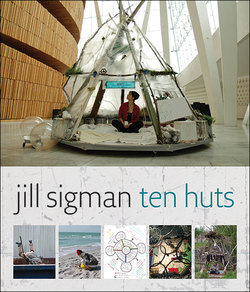Читать книгу Ten Huts - Jill Sigman - Страница 8
На сайте Литреса книга снята с продажи.
Оглавлениеforeword
I was looking for choreographers who could infiltrate. Wesleyan University’s Center for the Arts, which I directed from 1999 to 2016, had embarked on the Creative Campus Initiative, a program of curricular and co-curricular experiments that took the arts into non-arts areas of the university. We needed artists whose practice and spirit of inquiry would elevate the arts as a means of knowing and understanding the world, thereby expanding the number of students who consider the arts as central to their education and to their research methodology.
I met Jill Sigman for lunch and was immediately struck by the fact that, as a Ph.D. in philosophy from Princeton and as the Artistic Director of a company called jill sigman/thinkdance, Jill herself exists at the intersection of an artistic practice and multiple disciplines. She is quite simply not classifiable in terms of her art, nor where she lives in the academy. I found myself fascinated by her discovery that her academic research was not enough to fuel her inquisitive self and would not answer the questions that she was asking. She needed to return to her first research methodology: accessing the knowledge that is contained in the body in dialogue with space, time, and community.
In spring 2012, Jill co-taught a course at Wesleyan with anthropologist Gillian Goslinga that was titled “Ritual, Health and Healing” and was cross-listed in Anthropology, Science in Society, and Dance. The course asked questions including: Why are bodies and embodiment so critical to healing rituals? How do rituals heal and what do they heal? What can rituals contribute to the health of individuals and communities as a political project? Jill and Gillian made the decision to teach the course, in part, in dialogue with a real community: the community that gathered at St. Nicks Alliance in Brooklyn, helping to lay the groundwork for Jill’s Hut #7.
Throughout the journey of this class, Jill manifested the same generosity of spirit that you will find in this book. It is Jill’s generosity that led her to expand her teaching practice to include another scholar’s approach; her generosity that led her to open her commission from St. Nicks to include Wesleyan faculty and students; and her generosity that built the bridge between the community partners and members of the Wesleyan community that made it possible for two groups that would never have encountered each other to engage in an atmosphere of shared learning.
Jill Sigman’s work cannot be classified, and that’s a good thing. As you will see in this volume, she is at once a choreographer, performance artist, visual artist, writer, scavenger, gardener, philosopher, community organizer, healer, and so much more.
As you travel from hut to hut in this book, you will cross many thresholds, be invited into many different worlds, but the constant is Jill. You are there at her invitation and she is your guide. And if you allow yourself to become immersed in the worlds that she has created for you, you will come to understand what matters to her and thereby reflect on what matters to you.
Although you may not have experienced one of Jill’s huts in person, know that every photograph and word in this book was selected with the same level of care and intention that she put into collecting each object that made up each of the huts you see here.
To be an audience member for a work by Jill Sigman means to be an active participant. Whether it is following her to an abandoned lot or joining her for tea and conversation (a ritual that accompanied every hut iteration), Jill’s audiences are never merely observers: they engage. So, too, you will find invitations to engage at the end of each hut chapter in this book.
Collecting dead palm fronds at The Ringling.
SONJA SHEA
If you allow Jill to guide you, if you choose to take the hand of this artist whose hands so lovingly crafted each of these eleven huts, she will guide you to a place of contemplation and action. You may very well change your relationship to what you throw away, to what is disposable and dispensable, to how you think about when to engage and why you should, and how it feels when you do participate instead of standing outside the circle.
Jill Sigman’s huts catalyze new understandings of the world in which we live, where discarded objects find new meaning, where people of various walks of life meet each other, where plant life grows in unlikely places, and where the ordinary becomes sacred.
Pamela Tatge, Becket, Massachusetts
